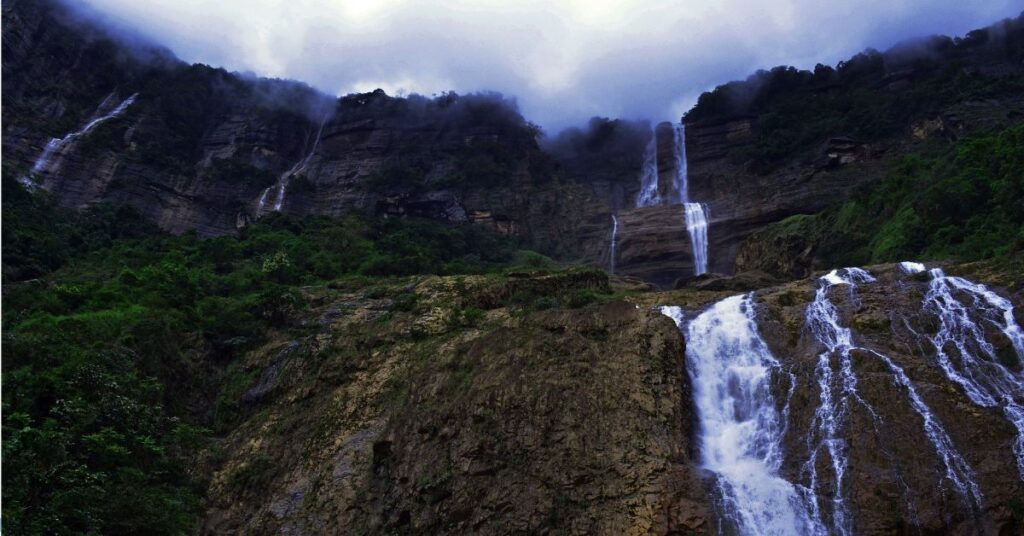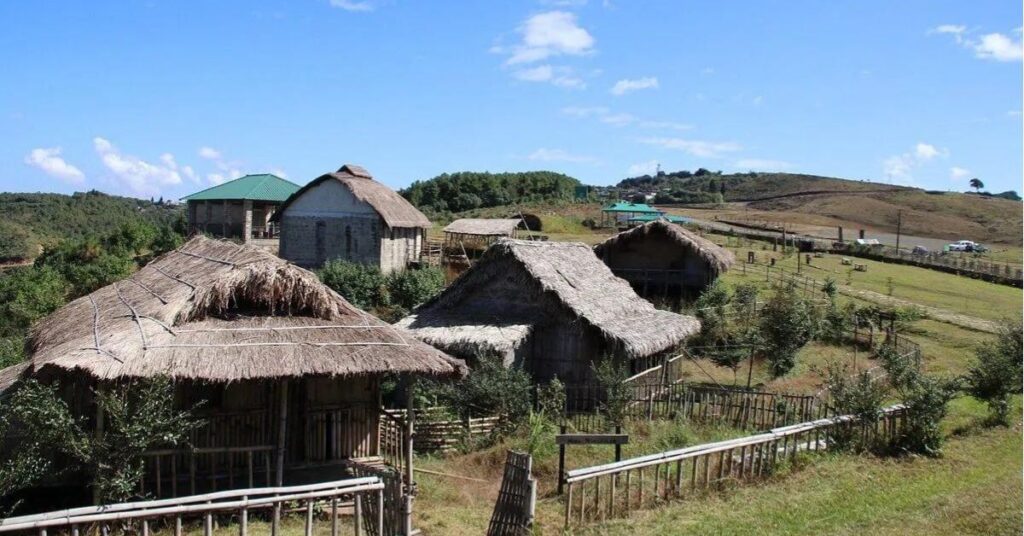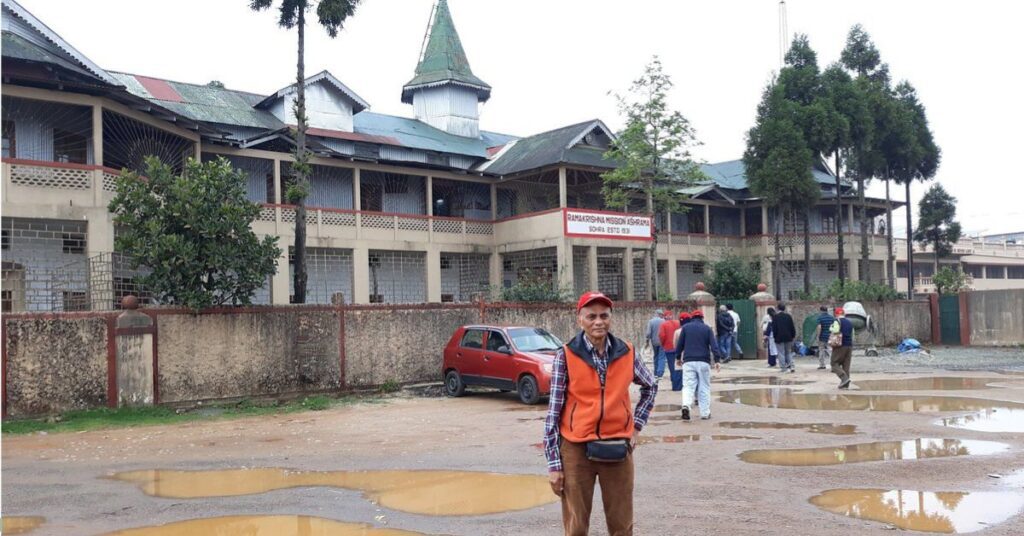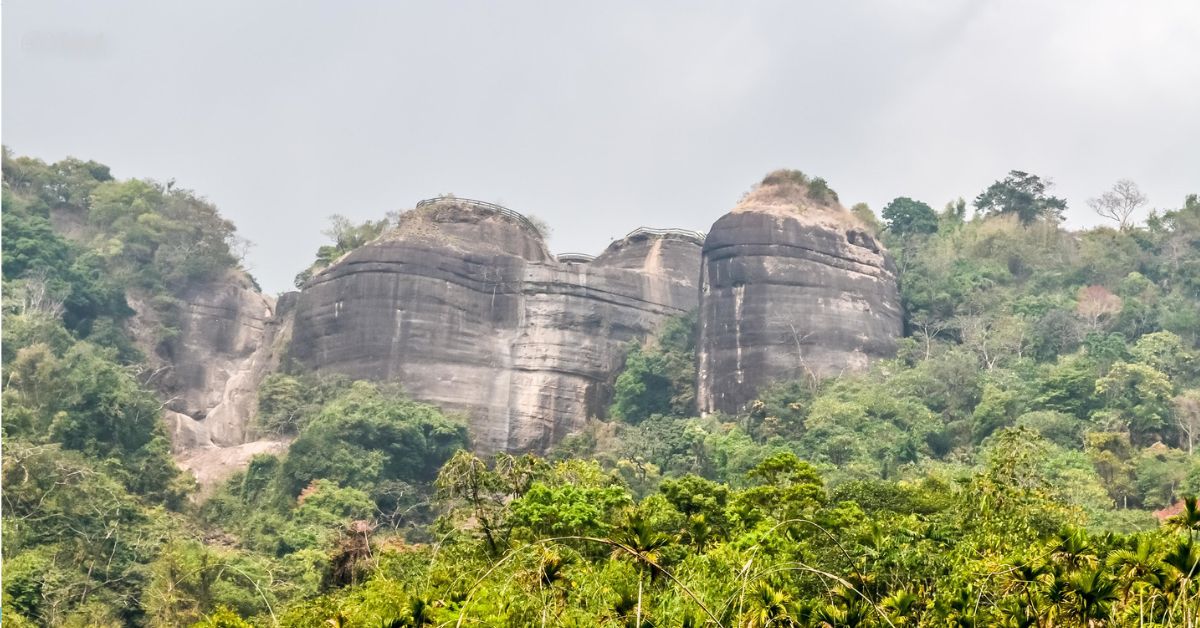Hidden in the green hills of Meghalaya is a giant rock called Khoh Ramhah, or the “Giant Basket.” Shaped by wind and water over many years, it’s a stunning example of nature’s amazing power. You can find it near Thangkharang Park in Cherrapunji. From there, you can see beautiful green hills and faraway valleys. Khoh Ramhah is like a giant rock sculpture with amazing views from every side. It’s a place where you can feel close to nature and see how beautiful Meghalaya really is.
How to reach:
By Car or Taxi
You can drive to Khoh Ramhah from Shillong. It’s about a 55 kilometer drive south on NH6 towards Cherrapunji. The journey takes around 2 hours, depending on traffic. The road passes through scenic places like Mawshbuit, Mawkynrew, and Mawpat. From Cherrapunji, head towards Thangkharang Park where you’ll find Khoh Ramhah.
By Public Transport
While public buses are available, they’re less frequent. You can take a bus from Shillong towards Cherrapunji. From there, you’ll need to arrange local transport to Thangkharang Park.
Guided Tours
Many tour operators in Shillong offer day trips to Cherrapunji, including Khoh Ramhah. This is a convenient option with the added benefit of local knowledge.
Best time to visit:
Post-Monsoon (October to February)
This is a great time to visit Khoh Ramhah. The weather is pleasant with cooler temperatures, perfect for exploring. The clear skies offer stunning views of the rock formation and surrounding landscapes. Water levels are lower, making it easier to appreciate the area. You’ll find fewer crowds compared to peak season, allowing for a more peaceful experience. The soft light is ideal for photography.
Pre-Monsoon (March to May)
The weather starts to warm up with increasing humidity as the monsoon approaches. The landscapes become lush and green. Tourist numbers gradually increase, especially towards the end of this season. You can witness the beauty of waterfalls and streams at their fullest.
Monsoon (June to September)
Meghalaya receives heavy rainfall during this period, transforming the landscapes with lush greenery and numerous waterfalls. However, visiting Khoh Ramhah can be challenging due to slippery paths and road conditions. It’s best to be well-prepared if you choose to visit during this time.
Attractions:
Kynrem Falls:

Kynrem Falls is a stunning waterfall near Thangkharang Park. The water crashes down from a very high cliff, making it a breathtaking sight. It’s surrounded by lush green trees and rocks, which makes it even more beautiful. The sound of the falling water is amazing, especially after it rains a lot. You can walk on paths to get closer to the falls and feel the cool water mist on your face. It’s like a refreshing escape from the hot weather.
Local Villages and Culture:

Discover the heart of Meghalaya by visiting nearby villages like Mawsynram or Mawlynnong. Meet the friendly Khasi people, known for their warm welcome and amazing skills like weaving and making things from bamboo. Try their delicious food and learn about their strong connection to the land. These villages are peaceful and relaxing, perfect for slowing down and experiencing the real Meghalaya.
Ramakrishna Mission Ashrama:

The Ramakrishna Mission Ashrama near Khoh Ramhah is a special place to learn about the history and culture of Meghalaya’s Khasi people. It has a museum with old things, like tools and art, that show how the people lived. The ashrama is peaceful and quiet, perfect for thinking and learning. It’s a great place to visit if you want to understand the culture and spirit of this part of India.
Local Experiences:
Discover Khasi Villages: Experience authentic Khasi hospitality and traditions in charming villages like Mawsynram and Mawlynnong.
Marvel at Living Root Bridges: Trek to Nongriat to witness and walk across these incredible natural wonders.
Savor Khasi Cuisine: Delight in local flavors with dishes like Jadoh, Doh Neiiong, and traditional teas.
Experience Khasi Culture: Immerse yourself in traditional music, dance, and storytelling performances.
Shop for Handicrafts: Explore local workshops and markets for unique bamboo and woven products.
Homestay Experience: Stay with Khasi families to understand their daily life and customs.
Connect with Nature: Join guided village walks to learn about local flora, fauna, and medicinal plants.
Celebrate Local Festivals: Participate in vibrant celebrations like Behdeinkhlam and Wangala.
Explore Tea Plantations: Discover the world of tea with visits to local plantations.
Embrace the Outdoors: Enjoy birdwatching, trekking, and nature walks in the surrounding hills.
Travel tips:
Weather Readiness: Meghalaya’s weather can be unpredictable. Pack for rain and fog, especially during the monsoon.
Footwear for Adventure: Wear sturdy shoes for hiking and exploring uneven terrain.
Local Guidance: Consider hiring local guides for enhanced experiences and insights.
Capture the Moments: Bring a camera with extra batteries and memory cards to capture stunning sights.
Respectful Travel: Adhere to local customs and traditions, especially when visiting villages or religious sites.
Travel Light: Pack essentials like water, snacks, sunscreen, insect repellent, and rain gear.Health and Safety: Carry necessary medications and a basic first-aid kit.
Travel Insurance: Protect yourself with comprehensive travel insurance.
Road Conditions: Drive carefully on winding roads, especially in remote areas.
Financial Planning: Carry sufficient cash as ATMs may be limited.
Environmental Stewardship: Dispose of waste responsibly and respect wildlife and natural habitats.
Language Tips: Learn basic Khasi phrases for better interactions with locals.
Conclusion
Meghalaya offers a captivating blend of natural wonders and cultural richness. From the awe-inspiring Khoh Ramhah rock formation to the cascading beauty of Kynrem Falls, the region’s landscapes are both breathtaking and diverse. Immerse yourself in the vibrant Khasi culture through village explorations, local cuisine, and traditional performances. Trek to living root bridges, discover hidden caves, and connect with nature’s wonders. Xplro.com’s comprehensive guide ensures a memorable journey through this enchanting corner of India.
FAQs
What is Khoh Ramhah?
- Khoh Ramhah, also known as the Giant Basket Rock, is a natural rock formation near Thangkharang Park in Cherrapunji, Meghalaya. It resembles a large basket carved over centuries by natural forces, offering panoramic views of the surrounding valleys and hills.
How do I reach Khoh Ramhah?
- Khoh Ramhah is accessible from Cherrapunji town by road. Visitors can hire a taxi or drive their own vehicle to Thangkharang Park, where Khoh Ramhah is located. The journey from Shillong to Cherrapunji takes approximately 1.5 to 2 hours.
What are the best months to visit Khoh Ramhah?
- The best time to visit Khoh Ramhah and Meghalaya in general is during the dry season, from October to May. The weather is pleasant, and visibility is better for enjoying the scenic views and outdoor activities.
What should I wear when visiting Khoh Ramhah and its surroundings?
- It is advisable to wear comfortable clothing suitable for trekking and walking, along with sturdy shoes. Pack layers as temperatures can vary throughout the day, and bring rain gear during the monsoon season.
Are there accommodations near Khoh Ramhah?
- Accommodation options are available in nearby Cherrapunji and Shillong, ranging from hotels and guesthouses to homestays. It’s recommended to book in advance, especially during peak tourist seasons.
What are some nearby attractions to visit along with Khoh Ramhah?
- Nearby attractions include Thangkharang Park, Kynrem Falls, Mawsmai Cave, Nohkalikai Falls, and local Khasi villages known for their cultural heritage and traditional practices.
Can I visit Khoh Ramhah with children and elderly family members?
- Yes, Khoh Ramhah and its surroundings are generally accessible to visitors of all ages. However, some trails and viewpoints may require moderate walking or climbing, so plan accordingly.
Are there guided tours available for exploring Khoh Ramhah?
- Yes, local guides are available at Thangkharang Park and nearby tourist centers. They offer informative tours that include insights into the geological history, local folklore, and cultural significance of Khoh Ramhah.
What activities can I do at Thangkharang Park besides visiting Khoh Ramhah?
- Thangkharang Park offers opportunities for picnicking, birdwatching, and enjoying panoramic views of the Kynrem Falls and Bangladesh plains. It’s a great spot for nature lovers and photographers.
Is photography allowed at Khoh Ramhah and Thangkharang Park?
- Yes, photography is permitted at Khoh Ramhah and Thangkharang Park. Capture the stunning landscapes and natural formations, but be respectful of local customs when taking photos of people.
What should I know about local customs and traditions when visiting Khasi villages near Khoh Ramhah?
- Respect local customs, dress modestly, and seek permission before photographing individuals or their property. Engage with locals respectfully and learn about their traditions and way of life.
Are there dining options near Khoh Ramhah?
- Yes, there are eateries and restaurants in Cherrapunji and nearby villages that offer traditional Khasi cuisine, as well as Indian and continental dishes. It’s advisable to try local specialties like Jadoh (rice and meat dish) and Doh Neiiong (pork with black sesame seeds).






